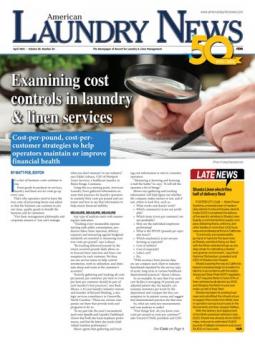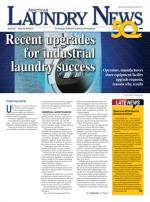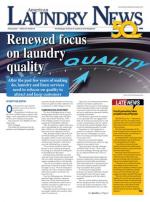Examining Cost Controls in Laundry & Linen Services (Part 1)

CHICAGO — It’s a fact of business: costs continue to rise.
From goods to products to services, laundry and linen service costs go up every year.
That’s why operators need to learn the true costs of processing linens and adjust so that the business can continue to put out clean, quality goods to benefit the business and its customers.
“Our basic management philosophy and corporate mission is ‘you can’t manage, what you don’t measure’ in our industry,” says Eddie Lefeaux, CEO of Westport Linen Services, a healthcare laundry in Baton Rouge, Louisiana.
Using this as a starting point, American Laundry News gathered information on some best practices for laundry operators to examine their costs per pound and customer and how to use that information to help ensure financial stability.
Any type of analysis starts with measuring key indicators.
“Tracking every measurable expense starting with utility consumption, productive labor, linen injection, delivery expenses and measuring against budgeted standards are essential in measuring your true costs per pound,” says Lefeaux.
“By tracking delivered pounds by the return received pounds daily allows us to forecast linen injection and linen consumption by each customer. We then use our service teams to help control inventories, work in utilization, and eliminate abuse and waste at the customer’s accounts.”
“Actively gathering and tracking all costs per pound, per customer, per item or even per item per customer should be part of each laundry’s best practices,” says Rudi Moors, a 32-year laundry industry veteran and founder of Beyond Washing, a strategic services consultancy in Greenville, North Carolina. “There are various companies out there that provide tools and programs to do so.
“In my past role, the ones I encountered most were Spindle and Laundry Dashboard. I know that both also track employee performance, and that the latter also tracks (individual) machine performance.”
Moors agrees that gathering and tracking cost information is vital in a laundry operation.
“Measuring is knowing and knowing is half the battle,” he says. “It will tell the operator a lot of things.”
Moors says gathering and tracking information will help figure out whether the company makes money or not, and if not, where to look first, such as:
- What works and doesn’t work?
- Which customer(s) is/are not profitable?
- Which items (even per customer) are not profitable?
- How are the individual employees performing?
- What is the PPOH (pounds per operator hour)?
- Which machine(s) is/are not performing as expected?
- Cost of utilities?
- Cost of materials?
- Labor cost?
- Etc.
“With accuracy from precise data, we can compare each client to industry benchmark standard by the service type of acute, long term or various healthcare departmental practices,” shares Lefeaux.
As an example, he says that if an acute care facility is averaging 19 pounds per adjusted patient day, the laundry can examine inventory par levels by the department and compare the line consumption to its patient census and suggest best demonstrated practices for that area.
So, what are some key measurements and cost analyses to make?
“First things first: do you know your costs per pound or costs per customer?” asks Gerard O’Neill, president and CEO of American Laundry Systems in Derry, New Hampshire, an independent consulting company that was established in 2003.
“If not, then let’s start there. The best advice I can give is to measure, measure, measure. Measure utilities, measure productivity of all staff (production, maintenance, sales, admin, drivers, customer service, etc.) even management.
“This does require some investment of equipment and software (to make your life easier) plus time and effort and/or can be done manually with pen and paper.”
O’Neill’s next piece of advice is for a laundry operation to first measure and compare against itself. He recommends doing this for four to six consecutive months.
“Establish a baseline, and then tackle the low-hanging fruit first and then go to the next level and the next and so on and so on,” he says.
The low-hanging fruit, according to O’Neill would be total and productive labor, linen replacement costs, and energy/utilities—what he calls The Big Three.
“Measure your labor for total labor and direct labor,” he says.
In PPOH, total labor includes everyone in the plant:
- Management and supervisors.
- Drivers.
- Customer service.
- Production employees.
- Maintenance/janitorial staff.
- Administrative staff.
Direct labor is production staff only (no supervisors, managers or maintenance staff).
“To calculate your PPOH divide your volume (in pounds or pieces) by the number of hours it took to perform the work and then divide that resulting number by the number of people/employees it took to do the work,” O’Neill says. “Here you would use both total staff numbers and then direct labor staff numbers.”
His example is a plant that does 200,000 pounds per week (40 hours a week) with 50 total staff and 25 direct labor staff. Divide 200,000 by 40 for 5,000 pounds per hour, and then divide 5,000 by 50 for 100 total PPOH, and then divide 5,000 by 25 for 200 PPOH for direct labor.
“Do this for four to six months, or longer if you have the patience, and you will start to see trends and notice when your PPOH numbers are up and or down from the average,” O’Neill says.
“Now you can analyze and see what customers are being processed at what times and are they the reason for spikes in PPOH, etc., or is it machine downtime or turnover, and the list goes on and on ‘ad infinitum.’
“But at least now you have started to measure and created a system and established a baseline to work with.”
He says that laundry operations should compare themselves to published industry standards or to peers, operators, cost group members, etc.
“But be sure to take ‘some’ of those numbers with a grain of salt as there are operators out there who inflate and do not count all staff as they should for bragging rights or for some reason or another,” O’Neill cautions.
“It is critical that you really do measure against yourself first and then to others second.”
Once the measurements and benchmarking are accomplished, he says an operation can now measure utilities, chemical usage, linen replacement, lost and damaged linen or uniforms, machine downtime, maintenance efficiency, machinery efficiencies, etc.
“As you can see, we have opened Pandora’s box, so to speak, where you can go with all of this, and it is a very worthwhile exercise no matter the cost in equipment or software that is available to help you manage and track all of this information,” he says.
“No matter the expenses, within reason of course, or the time and effort taken to accomplish your baselines for PPOH, energy/utilities, linen replacement, machinery efficiencies, etc., the results will literally astound you once you start to analyze and see the trends, problem areas, even discover problem customers.”
O’Neill says that at this point, an operation can address these in turn by using the PPOH numbers or the energy/utility numbers in Btus per pound and gallons per pound and so on such that profit margins per pound or per piece or per customer will increase dramatically.
“I have seen increases of 10-20% on average and even higher in plants that did not measure anything except on the direct labor production side alone,” he shares.
O’Neill concludes, “If you are not doing this, then you need to start and you need to start now.”
Check back Thursday for the conclusion about cost per pound per operator hour and making use of the data.

TRSA Advocates for Reusable PPE, PFAS Funding

Cost Control in Motion for Laundry/Linen Delivery

Cultivating Trust in Laundry Teams (Conclusion)

Cultivating Trust in Laundry Teams (Part 1)

Record-Breaking Attendance at ALM’s 2024 IMPACT Conference

Dialing in Chemical Representative/Laundry Relationships (Conclusion)

Xos Accelerates Growth with Acquisition of ElectraMeccanica

Dialing in Chemical Representative/Laundry Relationships (Part 1)

Cintas Named One of Forbes’ America’s Best Large Employers

Improvements are Constant in the Laundry Game
Podcasts for You
Culture Shock: Is Your Laundry Really a Good Place to Work?

Kris Boesch, CEO and founder of Choose People, a company dedicated to helping change company cultures so employees feel good about going to work, talks about creating a positive workplace culture.
Panel of Experts: Richard Engler, JPS Health Network

Richard Engler, textile processing department manager for JPS Health Network in Fort Worth and a Panel of Experts author for American Laundry News, talks about his life in laundry services.
We’re Heading for Recession! Now What Do I Do?

Bryan Cutsinger, assistant professor of economics at Angelo State University in Texas, and Mike Knowles, COO of Superior Linen Service in Oklahoma, talk the economy, the possibility of recession and ways to ride out the downturn.
From the Research Center
Water Recycling in Commercial Laundry

Laundry Design & Construction: Creating the Ideal Workflow

Laundry Chemicals & Dispensing: Finding the Right Chemistry

Latest Digital Editions
Digital EditionAmerican Laundry NewsApril 2024

- Examining Cost Controls in Laundry & Linen Services
- Improvements are Constant in the Laundry Game
- Dialing in Chemical Representative/Laundry Relationships
- Cultivating Trust in Laundry Teams

